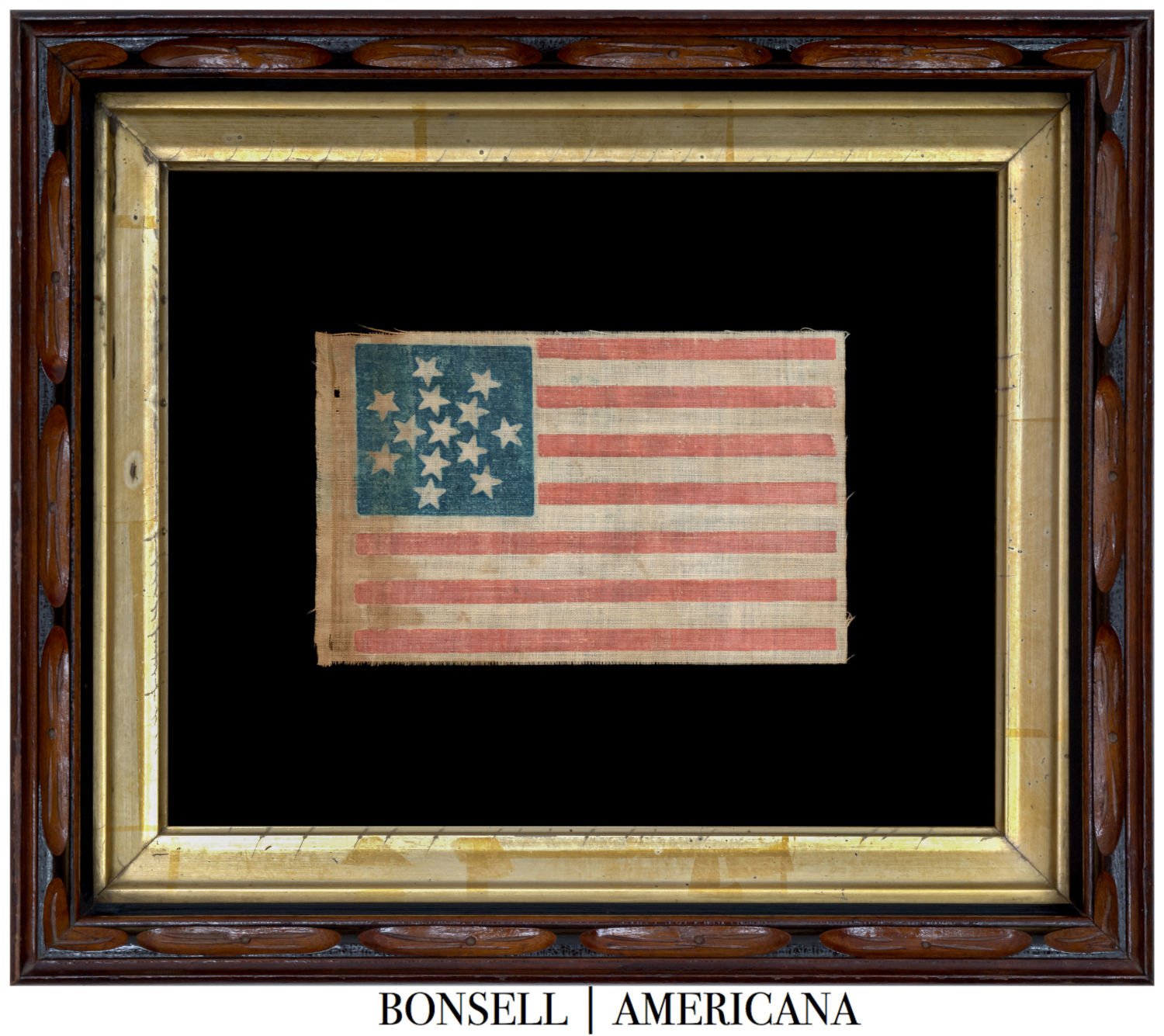36 Star Antique Flag with a Rare Medallion Defining a Grand Luminary Configuration | Nevada Statehood | Circa 1864-1867
36 Star Antique Flag with a Rare Medallion Defining a Grand Luminary Configuration | Nevada Statehood | Circa 1864-1867
Frame Size (H x L): 22” x 29”
Flag Size (H x L): 11.5” x 18”
Offered is a thirty-six star antique flag printed on coarse glazed cotton. It is a medium sized flag that is big enough to make a statement, yet small enough that it can be displayed almost anywhere.
The stars of this flag are in a whimsical medallion configuration. Upon initial inspection, the stars thereof appear to be arranged randomly. But upon closer inspection, the inner stars of the medallion are arranged purposely, so as to define a “Grand Luminary” configuration. This combination—basically, a medallion that defines a Grand Luminary, not to mention the flanking corner stars—is amongst the most rare and desirable configurations one will ever encounter.
The Grand Luminary configuration is a large star made of smaller stars. The smaller stars may be a variety of sizes, and they may be canted in a variety of directions. Such a configuration was for a time perfectly acceptable, as prior to an Executive Order in 1912, flag makers were free to place the stars however they wished.
US Naval Captain Samuel Reid is credited with designing the Grand Luminary configuration in 1818. Reid was an officer in the US Navy and commanded the privateer General Armstrong during the War of 1812. Andrew Jackson credited Reid's heroism in delaying the British Squadron in the Battle of Fayal and aiding in General Jackson's defense of New Orleans. Reid and his crew were considered heroes.
The Second Flag Act, passed in 1794, stated that the flag would have fifteen stars and fifteen stripes, in response to Vermont and Kentucky being added to the Union. Knowing that this approach would be unsustainable, with Reid's help, Congress passed the Flag Act of 1818, specifying that the flag should have thirteen stripes and a star for each state admitted to the Union. It further specified that the addition of each star should be on the Fourth of July following each respective state's admission.
Reid played a significant role in the Flag Act of 1818, and in doing so, he recommended several potential star configurations, including twenty stars in the shape of a larger star for general use. Reid suggested this configuration to make the flag consistent and easily identifiable, particularly at long distances and at sea. His star configuration recommendation was not ultimately included in the Act, nor was any star configuration, but still Reid is universally credited with designing the Grand Luminary. Its use peaked in the 1840s, but it was also used during the Civil War and occasionally during Centennial Celebrations. Its last known commercial use was on thirty-eight star flags.
Thirty-six star flags represent the inclusion of Nevada to the Union, and such flags were waved in celebration of the conclusion of the Civil War. Nevada was admitted on October 31st, 1864, and this flag became official on July 4th, 1865. Nevada was originally part of the Utah Territory beginning in 1850, became its own territory in 1861, and became its own state in 1864.
The timing of Nevada's inclusion was politically and economically based. For political reasons, Nevada was admitted to the Union just eight days prior to President Lincoln's re-election bid against General George McClellan. Such timing was meant to benefit Lincoln and his fellow Republicans. For economic reasons, Nevada was included as part of the Union to help it pay off the country’s war debts. Economically, Nevada was particularly attractive at the time, because of its significant silver mining industry. Nevada expanded its borders in 1866 when the western Utah Territory was added to its eastern side, and further expanded in 1867 when a portion Pah-Ute County in the Arizona Territory was added to its southern side.
The thirty-six star flag was the official flag for the last six months of the Civil War, and was used by the military during that time. It was also the official flag during a portion of the Reconstruction era. The thirty-six star flag was official until July 4th, 1867, the time at which the thirty-seven star flag became official and began to represent the inclusion of Nebraska in the Union.
Conservation Process: This flag was hand sewn to cotton fabric, and both were hand sewn to a mounting board. To prevent the black dye in the cotton fabric from seeping into the flag, it was first washed in a standard wash and then in a dye setting wash. The flag is positioned behind Conservation Clear Acrylic (standard) or behind Optium Museum Acrylic (per request).
Frame: This flag is in a multitiered frame with an outer walnut layer and an inner gilded layer. It dates to between 1860 and 1890.
Condition Report: There is a small tear that runs parallel to the hoist edge. The small tear begins at the bottom edge and extends approximately two inches. We masked the tear with old glazed cotton. Thus, the tear has been camouflaged. There is minor fading through the blue canton and the red stripes. There is notable fading located across the top of the canton. Further, there is notable fading and staining that is vertically oriented near the fly end (i.e., the 20% closest thereto). This flag was likely rolled and placed into storage. Over time, the outermost portion of the roll was damaged, while the innermost portion was protected. Such damage is encountered in many antique flags, because they were easiest to store in this fashion, particularly those of which that were attached to a staff. Its overall appearance is age appropriate and extremely attractive. Simply put, this is the appearance that collectors desire.
Collectability Level: The Best – Perfect for Advanced Collectors
Date of Origin: 1864-1867
Number of Stars: 36
Associated War: Civil War (1861-1865)
Associated State: Nevada









